Welcome to the Jellyfish Treehouse!
Be sure to play "Don't Get Stung by the Jellyfish"
(play after you learn about jellyfish below)
Common name: Jellyfish Scientific name: Scyphozoa
Classification
Jellyfish are part of the Animal Kingdom. They are invertebrates, which means they do not have a backbone. They are in the phylum Cnidaria and most jellyfish are in the class Scyphozoa. Jellyfish are also referred to as Medusas.
What do jellyfish look like?
Many people think of jellyfish as little creatures in the ocean that sting you. Not all jellyfish are harmful. The stinger on most jellyfish cannot even be seen. Hydromedusae, clear jellyfish, don't sting you when you touch them. Jellyfish have a gastric cavity, this means that they only have one opening as a mouth and an anus. Jellyfish do not have a brain, heart, gills, kidney or liver. Many jellyfish have tentacles which they use for feeling and grasping. They use these tentacles to grasp other creatures or plants (fish, plankton) to eat as food.
Harmful Jellyfish
The Red Mane, also known as the Lion Mane Jellyfish, Cyanea capillata, is extremely dangerous. The tentacles of the Lion Mane jellyfish can grow up to 200 feet long and the actual body of the jellyfish can grow up to eight feet! Pelagia noctiluca or Purple Jellyfish are also very harmful and should definitely be avoided. The Purple Jellyfish can grow up to 40 centimeters across. It has five tentacles surrounding its mouth, that are used for feeding. Both the Purple Jellyfish and the Lion Mane Jellyfish are found in New Jersey.
Common Name: Moon Jelly Scientific Name: Aurelia aurita

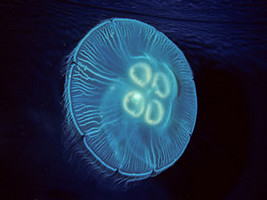
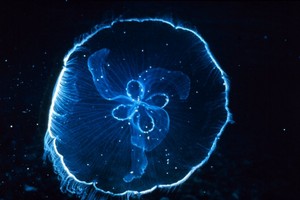
Left image © 2005 Dave and Debra Wrobel. Right image courtesy NOAA Photo Library
Moon Jellys are also found in New Jersey. Moon Jellys are part of the Semaeostomeae order, Ulmaridae family, Aurelia genus, and A. aurita species. It's binomial name is Aurelia aurita. The tentacles of a moon jelly are attatched under the "umbrella shaped body." Moon Jelly are harmless to humans.
Life Cycle
The life cycle of a jellyfish is shown in the picture above. The male jellyfish releases a sperm into the water and this matches up with an egg released by a female jellyfish. The sperm and the egg are formed in the gonad. When the sperm and the egg fuse, they make a fertilized egg. A larva or Planula then forms and this attaches to a rock or another object on the bottom of the water and this is known as a polyp. The polyp folds over on itself creating a "colony of polyps" or Strobila. Each of the polyps in the colony detach and are medusae or adult jellyfish. Most jellyfish live less then a year.
Time to test you jellyfish knowledge!
Game: Don't Get Stung By the Jellyfish!
Materials:
- Trivia cards (cut out)
- Click here for trivia cards, then click download document:
 View jellyfishcards1.doc These are trivia cards to review what you learned with a fun game! Follow the directions below.
View jellyfishcards1.doc These are trivia cards to review what you learned with a fun game! Follow the directions below.
- Chance cards (cut out)
- Click here for chance cards, then click download document:
 View game.doc
View game.doc - Gameboard
- Click here for the gameboard or click on the thumbnail of the gameboard below for the version you should print out. Here you will find the actual gameboard!
- 1 die
- Answer key for questions (see below)
- Game pieces of your choice!
Directions:
- Make a pile of question cards and a pile of chance cards next to the gameboard.
- The first person rolls the die and moves as many spaces as the number that they have rolled.
- If you land on a blue square, you pick a question card
- If you land on a "!" square, you pick a chance card.
- If you land on a square that crosses over, you have to cross over, even if it's backwards!
- If you have to answer a question, if you answer it right, you move ahead one space, but if you answer it incorrectly then you stay where you are. Have fun and good luck!
- The first person to make it to the end wins!
Answer Key for Trivia Cards:
- Cnidarians
- Medusa
- high tides
- On most jellyfish you can not see the stinger
- Both sexual and asexual
- Lion Mane or Red Mane
- up to 200ft
- eight feet
- Clear jellyfish
- false
- true, extremely dangerous
- true
- Gonad
- Planula
- Rock or another object on the bottom of the water
- false
- Gastric cavity
- One opening for both the mouth and the anus
What do you think?
My fellow classmate, Josh, read my webpage and played the game. He felt that the game really helped him review what he learned from the site and that it was very educational.
Sarah said, "I think it's a very convenient way to study. Everything is on one page and is easily accesible. It's much easier then opening both notes and text."

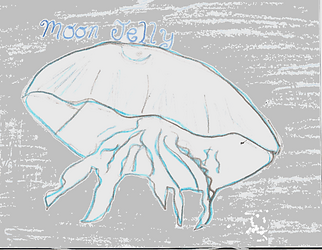
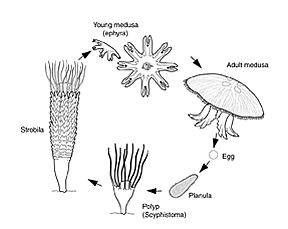
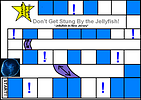


 Go to quick links
Go to quick search
Go to navigation for this section of the ToL site
Go to detailed links for the ToL site
Go to quick links
Go to quick search
Go to navigation for this section of the ToL site
Go to detailed links for the ToL site